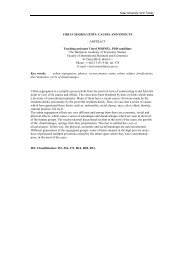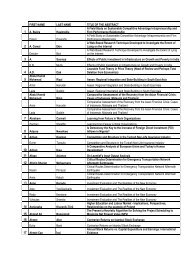Indre Jucaityte
Indre Jucaityte
Indre Jucaityte
Create successful ePaper yourself
Turn your PDF publications into a flip-book with our unique Google optimized e-Paper software.
As already mentioned in the previous section, Keller (2003) pyramid of brand value<br />
creation consists of four steps (6 blocks) (Fig. 1). The first step of creating brand identity<br />
and brand associations refers to specific product or service category or customer needs.<br />
Here are formed the foundation of pyramid by developing brand value. In the second step<br />
brand meaning in the minds of customers is created, strategically linking a number of<br />
obvious and intangible brand associations, which can be divided into two parts: the<br />
functionality of the brand and brand image. However, in order to reveal consumers'<br />
emotions, as mentioned above, one should lead to the pyramid on the right side. Thus, the<br />
brand image is what people think about brand in theory, rather than the brand really is.<br />
This is a very important feature of the brand, which reveals how the brand satisfies the<br />
consumers' psychological and social needs. The objective of third step is to induce the<br />
desirable reaction of consumers to the brand identity and brand value creation. In the right<br />
side we see consumers’ senses and emotions block. According to Keller (2003), brand<br />
feelings are emotional responses and reactions of customers by feeling respect for the<br />
brand. These feelings can be gentle and strong, positive and negative. All the emotions of<br />
each consumer tend to be displayed differently depending on the brand, with which they<br />
are associated, i.e. at the moment when consumer thinks about certain brand. In order to<br />
explain the consumers' feelings and emotions block in detail, Keller (2003) also identifies<br />
certain sub-dimensions: sincerity, security, empathy, safety, social recognition and selfesteem<br />
(Fig. 1).<br />
So, block of consumer feelings and emotions in Kellers’ (2003) brand value creation<br />
pyramid can be associated with a block of Lavidge and Steiner (1961) presenting the<br />
model of emotional impact. Lavidge and Steiner model is one of the first, which included<br />
the emotions, and argued that emotions are consequence of our thoughts. In this model<br />
three levels of advertising exposure are distinguished: cognitive (mind field), conative<br />
(motives, conduct field) and effective (emotional domain) (Fig. 1). Early model of<br />
emotional impact shows that contemplation of information leads to feelings, which form<br />
or change the approach to product, and as the final stage, creates the desire to buy.<br />
After the analysis of scientific literature, it can be argued that the modern theory of<br />
branding by senses suggest, that emotions influence consumer buying decisions. Feelings<br />
that are affected by the five senses also increase brand value to the comsumer. Based on<br />
an early model of the emotional impact, the modern model of emotional impac is<br />
presented (Fig. 1). The model contains the main sensory dimensions – image, sound,<br />
smell, taste, touch, which causes certain feelings, emotions, and these form a brand image<br />
to consumers. The feelings influenced by five human senses affect people thinking,<br />
attitudes, and later influence their decisions. Impact of all these senses can create a strong<br />
brand and distinguish the brand over its competitors, thereby increasing customer loyalty<br />
and brand value. The more senses are used to the brand, the stronger it will be and the<br />
greater its value. For each sense the particular stimuli are distinguished, that influence<br />
each sense independently.<br />
Image stimulus may be color, light, form, space, variety of designs and ads.<br />
Sound stimulus may be background, language, communication, music and silence.<br />
6




